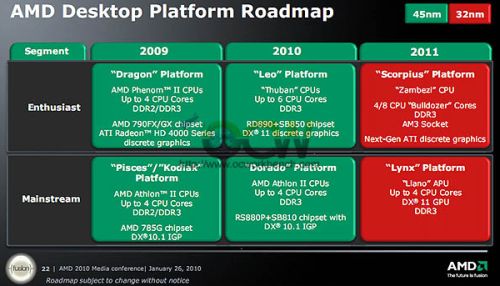AMD held a press conference in Singapore today, discussing the company's plans for 2010 into 2011. The chipmaker said it would focus on pushing its transition to 45nm fabrication tech for improved performance and power efficiency in desktop and notebook parts.
There is also a major emphasis on graphics technology – as you might expect from a company who has finally beat its competitor to the punch. AMD will offer more OpenCL and DirectCompute 11 developer tools and hardware optimizations. More 40nm DirectX 11 products are planned across all budgets, and the manufacturing process will be sped up.

"Immersive gaming" with DX 11 graphics is a focal point of the Leo desktop platform, which will be phased in this year to compete with Intel's 32nm Clarkdale products, and includes six-core chips. The more flexible mainstream Dorado desktop platform will also launch this year, featuring "next-generation integrated graphics".
Notebook platforms for 2010 include Danube and Nile. The former is a mainstream solution that will bring triple and quad-core computing, DirectX 11 graphics, and 7-hour resting battery life. The latter is AMD's ultrathin platform, offers an 11% performance improvement and nearly 7.5 hours of resting battery time.

Things get a bit more exciting in 2011, which should see the arrival of AMD's overdue CPU+GPU hybrid Fusion processors along with 32nm technology and various new platforms including the enthusiast desktop Scorpius, mainstream desktop Lynx, mainstream notebook Sabine, and ultrathin Brazos.
Scorpius will be comprised of the Zambezi and Bulldozer CPUs, socket AM3, and next-generation discrete graphics. Meanwhile, Lynx and Sabine will use Fusion-based Llano APUs, Brazos will have an Ontario APU, and all of them will use DDR3 RAM and DirectX 11 graphics.